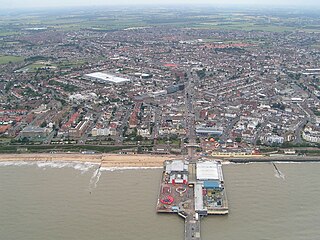
Clacton-on-Sea is a seaside town in the Tendring District in the county of Essex, England. It is located on the Tendring Peninsula and is the largest settlement in the Tendring District with a population of 56,874 (2016). The town is situated around 76.9 miles north-east of Central London, 40 miles from Chelmsford, 57.9 miles from Southend-on-Sea, 15.8 miles south-east of Colchester Town and 16.3 miles south of Harwich. The town is a seaside resort, located on the east coast of England.
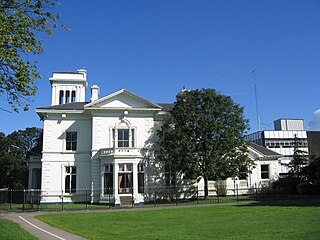
Runcorn Town Hall is in Heath Road, Runcorn, Cheshire, England. It is recorded in the National Heritage List for England as a designated Grade II listed building. It was originally built as Halton Grange, a mansion for Thomas Johnson, a local industrialist. After passing through the ownership of two other industrialists, it was purchased in the 1930s by Runcorn Urban District Council and converted into their offices. Since 1974, it has been the meeting place for Halton Borough Council.
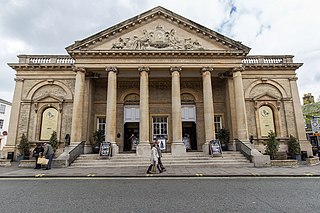
Corn exchanges are distinct buildings which were originally created as a venue for corn merchants to meet and arrange pricing with farmers for the sale of wheat, barley, and other corn crops. The word "corn" in British English denotes all cereal grains, such as wheat and barley. With the repeal of the Corn Laws in 1846, a large number of corn exchanges were built in England, particularly in the corn-growing areas of Eastern England.

Macclesfield Town Hall is a Georgian municipal building in the Market Place of Macclesfield, Cheshire, England. Dating originally from 1823–24, it was designed by Francis Goodwin in the Greek Revival style, and extended in 1869–71 by James Stevens and again in 1991–92. The building incorporates the former Borough Police Station. The town hall is listed at grade II*.

Chatham Town Hall is a municipal building in Dock Road in Chatham, Kent, England. The town hall, which was the headquarters of Chatham Borough Council, is a Grade II listed building.

Great Yarmouth Town Hall is a municipal building in Hall Plain, Great Yarmouth, Norfolk, England. The town hall, which is the meeting place of Great Yarmouth Borough Council, is a Grade II* listed building.

Chadderton Town Hall is a municipal building on Middleton Road, Chadderton, Greater Manchester, England. The town hall, which was the headquarters of Chadderton Urban District Council, is a grade II listed building.
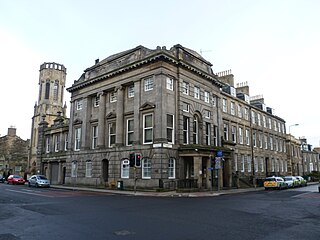
The Old Town Hall is a municipal building in Queen Charlotte Street, Leith, Scotland. The old town hall, which was the meeting place of Leith Burgh Council, is now used as a police station. It is a Category A listed building.
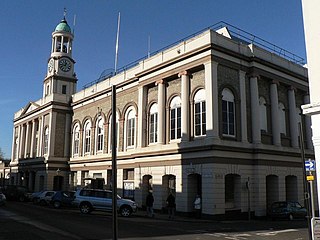
Ryde Town Hall is a municipal structure in Lind Street in Ryde, Isle of Wight, England. The town hall, which was the headquarters of Ryde Borough Council, is a Grade II listed building.

Llandudno Town Hall is a municipal structure in Lloyd Street, Llandudno, Wales. The town hall, which serves as the meeting place of Llandudno Town Council, is a Grade II listed building.

Purley Council Offices, also known as Purley Town Hall, is a former municipal building in Brighton Road, Purley, London. The structure, which was the headquarters of Coulsdon and Purley Urban District Council, is a Grade II listed building.

Wednesbury Town Hall is a municipal building in Holyhead Road in Wednesbury, West Midlands, England. The structure, which was the meeting place of Wednesbury Borough Council, now operates as an events venue.

The Municipal Buildings are based in Corn Exchange Road, Stirling, Scotland. The structure, which was the meeting place of Stirling Burgh Council, is a Category B listed building.

Otley Civic Centre is a municipal structure in Cross Green, Otley, West Yorkshire, England. The structure, which was the offices and meeting place of Otley Town Council, is a Grade II listed building.

Saltcoats Town Hall is a municipal building in Countess Street, Saltcoats, North Ayrshire, Scotland. The building, which is used by North Ayrshire Council as hub for the delivery of local services, is a Category B listed building.

Lutterworth Town Hall is a municipal building in the High Street in Lutterworth, Leicestershire, England. The structure, which operates as a community events venue, is a Grade II listed building.

The Old Town Hall is a former events venue in Prince of Wales Road, Cromer, Norfolk, England. The structure, which is currently used for retail purposes, is a grade II listed building.

Denny Town House is a municipal building in Glasgow Road, Denny, Falkirk, Scotland. The structure is used by Falkirk Council for the provision of local services.
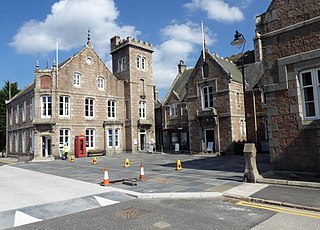
The Victoria and Albert Halls is a complex of municipal buildings in Station Square, Ballater, Aberdeenshire, Scotland. The structure, which accommodates the new Ballater Community and Heritage Hub, is a Category C listed building.

Hamilton Sheriff Court is a judicial building in Almada Street, Hamilton, South Lanarkshire, Scotland. The building, which continues to serve as the local courthouse, is a Category A listed building.






















